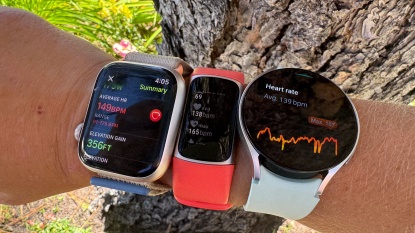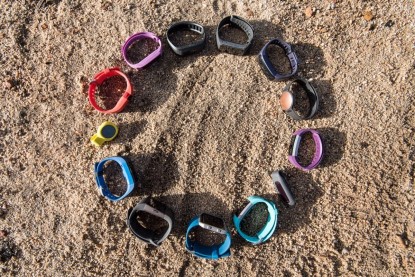
Our Verdict
Our Analysis and Test Results
The Fitbit Charge 6 is the latest version of a popular line of fitness trackers. We tested the Charge Hr in 2016 and have seen tremendous innovation in the technology and the associated app since then. One thing that hasn't changed, however, is the signature comfort and the overall minimalism. You can wear a Charge 6 24/7, collect tons of meaningful data on your health, and don't have to obsess over an overly large or overly expensive wearable device.
Fitness Impact
Thanks to the built-in GPS, autodetection capability, and various sensors, the Charge 6 has the fundamentals to support a budding athlete or someone who prioritizes fitness. However, we did uncover some issues with heart rate accuracy, and we have read about some Charge 6 users who are disappointed with the Community features that were discontinued in March 2024. Still, this tracker has a number of qualities that might make it a great choice for you.
GPS
Bravo to Fitbit for including a GPS antenna in such a low-profile tracker! We love the fact that our outdoor activities can be tracked without a smartphone. However, your ability to navigate with the tracker is limited due to the tiny screen.
Elevation
Unfortunately, an altimeter is not included with the Charge 6, so you need to rely on the GPS to determine elevation from a digital map rather than via direct measurement. This isn't as accurate as a barometric altimeter, but you can still acquire elevation gain and loss data.
Distance Precision
When we tested the Charge 6 on runs or walks, we found that it was about 85% accurate. We also tested its ability to measure distance on the treadmill; however, it was much more consistent with tracking runs than walks.
Walking and Step Score
The Charge 6 undercounted or overcounted steps on successive trials. Nonetheless, it had an error rate of less than 1%, which is certainly good enough in our book!
Workout Tracking
It is interesting that the Charge 6 records more data with auto-detected runs and workouts than it does for manually tracked workouts. Our lead tester found this frustrating: “I want all my stats like max and average HR regardless of whether I started tracking or if Fitbit started the tracking.” There was also some inconsistency with the information it showed on the screen; sometimes, we couldn't see our heart rate data while we were exercising and had to wait until the workout was complete.
There are a number of useful features for workout tracking, which include turning off notifications, heart rate zone prompts (so you know when you are in a certain zone), and setting intervals, rests, and reps for HIIT workouts. However, our lead tester shared that she wishes “that heart rate was more readily available on the screen during workouts.”
That being said, we really liked the Coach tab in the app, where we could sort through workouts and explore fitness class offerings, guided meditations, and menu suggestions. However, it is necessary to pay for a Premium membership to gain access to most of these features.
Trackable Activities Available
The Charge 6 provides a shortcut menu for selecting five activities that you participate in frequently. Most of the well-known activities can be selected, but the more niche sports aren't available. Nonetheless, you should be able to find a similar enough activity for tracking purposes.
Community
In March 2024, Fitbit discontinued some features of the online Fitbit community, such as Challenges, Adventures, and open groups. We have read that many Fitbit devotees are disappointed and feel the loss of something that makes fitness rewarding for them. We noted that there are new community features on the app and ways to connect with family and friends, but some users feel it just isn't the same.
Health Impact
The Charge 6 is a great choice for individuals who want to track their diet, take advantage of health data like blood oxygen and EKG, and monitor their sleep. However, if you are a tech-savvy enthusiast or rely on heart rate data to manage specific medical conditions, you should be aware of some HR accuracy issues with the Charge 6.
Heart Rate
If you aren't deadset on accurately knowing your heart rate at any given point in time, particularly during an interval workout, the heart rate monitor in the Charge 6 will suffice. That being said, when we had pegged our heart rate during multiple workouts, the Charge 6 took 10 seconds to catch up, at which point our heart rate had already slowed down.
Diet
The Fitbit can integrate beautifully into your lifestyle as a diet tracker. It is feature-rich without being tricky to use. You can easily adjust the amount of food consumed, and there is a bar code reader in the app to make it effortless to enter items. The calorie consumption can also be easily adjusted, and there's a nutrient breakdown that includes total fat, protein, and vitamins. With a premium subscription, you also get access to short videos on meal preparation.
Additional Health Indicators
Although the Charge 6 doesn't determine training load recovery, it does have a suite of sensors for determining blood oxygen, EKG, skin temperature, heart rate variability, respiration rate, and movement. These generate data on your VO2 max, stress, and activity patterns. It also pairs with Fitbit scales and includes a sedentary reminder as well as a daily progress bar. Not to mention, it monitors your stress level and provides a measure of overall stress management. Overall, it is easy to track behaviors, but there isn't a ton of detail in this area. One of our testers pointed out that they missed the features “for tracking lifestyle patterns like drinking water, taking supplements, reading with UV glass before bed” that some other trackers have.
Sleep Tracking
The data and sleep record of the Charge 6 aligned, for the most part, with the other trackers we used in our side-by-side tests of sleep tracking. The results also seemed accurate when compared to our perceptions of sleep quality. Our main issue with the Charge 6 is that sometimes there was a lengthy delay before our sleep data was uploaded (we went through a litany of adjustments to resolve this but were not successful). However, we really like the sleeping scoring system, which is easy to interpret.
Ease of Use
Overall, the Charge 6 is easy to use day to day. We like how it doesn't get in the way, but the corollary to that benefit is a small screen, which makes it tricky to view or navigate unless you are standing still.
Getting Started
It was a snap to get the Charge 6 and the Fitbit app set up and working. We encountered an issue when trying to use it with a Google Workspace account, but once we created a new individual account, we got back on track. It took about a week for the Charge 6 to calibrate to your biometrics, at which point it generated our heart rate variability score.
Phone App
Data and information are organized in a simple way on the app. You can set up a customized home screen to present the metrics you want to focus on. Our lead tester appreciated that “it's organized in a way that makes sense and isn't overwhelming or cluttered with clickbait.” However, an issue for the testers was that the app offers limited information when reviewing a workout; you just get an overview rather than a workout analysis. On top of that, the record of manually initiated activities contained much less data than the autodetected activities.
Wearability
It takes a little bit of practice to put on the Charge 6, but we figured it out quickly. Once on your wrist, it has a seamless quality to it. The only time we noticed it was when putting on a shirt with very tight sleeves. Otherwise, it slipped through jacket sleeves or the straps on our backpacks.
Display
The display is bright, but due to the size, it can be a little tricky to view biometrics while running, biking, or training in the gym. We felt like we had to stop and focus in order to check on tracking data or to view HR data.
Connectivity
The Charge 6 connects easily to apps like Strava, and there is an option for music control as well as for a wallet and maps. Texts, calls, and push notifications are available on the screen, but it isn't easy to read the text! There is a “quick reply” function, however, which is convenient.
Subscriptions
You get a free six-month Fitbit Premium membership with the device, but once that is up, access to some features is restricted.
Water Resistance
The Charge 6 is rated to five atmospheres and performed beautifully when swimming or showering. We have used touchscreen devices that accidentally paused activities when exposed to water, but we didn't have any issues with the Charge 6.
Battery
As much as we loved the Charge 6 overall, we experienced some frustration when it came time to charge it. It is necessary to carefully lining up two magnetic points on the cord with the charge port, and multiple times, we couldn't get the band to accept a charge. After cleaning the contacts and making several attempts, we got it to work, but we wonder if this could develop into a bigger issue with extensive use.
The battery life of the Charge 6 will depend a lot upon the wearer and the length of activity. Our lead tester burned through the battery in less than forty-eight hours during one weekend, although we acknowledge that she is an extremely active person! For most people, the tracker should last for approximately seven days. The issue is rooted in the autodetection characteristic of the tracker, so more activity will naturally place a heavier load on the battery.
Fit
We found the Charge 6 to be remarkably comfortable. In fact, we quickly got to the point where we forgot it was there!
Should You Buy the Fitbit Charge 6?
The Charge 6 is a great option for beginner athletes or someone who wants to track their fitness and lifestyle but doesn't need to dive deeply into performance or biometrics. It is also a great choice for someone who wants to track sleep and daily activity but prefers a tracker that will fade into the background while still offering a small display.
What Other Fitness Trackers Should You Consider?
If you are a serious athlete, we recommend also looking at the Garmin Forerunner 965 or the Garmin Vivoactive 5 for devices that will provide excellent tracking performance and enable the wearer to easily monitor heart rate, pace, distance, and duration during a workout. If you want a fitness tracker that is as minimal as possible, we suggest you also look at the Oura Ring Gen 3 for a ring-style tracker or the Whoop 4.0 for a wrist-style tracker (the Whoop can also worn in specially designed Whoop garments for the ultimate in tracker integration.













